A shipping container basement is a creative and practical solution for homeowners looking to expand their living space without extensive construction costs.
By repurposing shipping containers, traditionally used for transportation, as a basement structure, you can create a unique underground living area with several exceptional benefits.
Note that there is a difference between a shipping container with a basement, and a shipping container that is used a basement.
Table of Contents
Unique Features and Benefits
Shipping container basements offer unparalleled durability and sturdiness. These steel structures are designed to stand against extreme weather conditions, making them resistant to moisture, pests, and other external threats.
Additionally, their modular nature allows for easy customization, enabling homeowners to design a basement that suits their specific needs and preferences.
Moreover, shipping container basements are an eco friendly alternative to traditional construction methods. By repurposing containers, you add to the reduction of waste and promote sustainability.
Below you can see the end results of a shipping container used as a basement for a home. The total cost of the basement project came to about $12,500.
The tools and materials needed for the project was a bunch of basic tools, a watertight 20 foot shipping container, concrete, rebars, and L-beams for added support. A backhoe, or good elbow grease, will also be needed for digging up the basement.
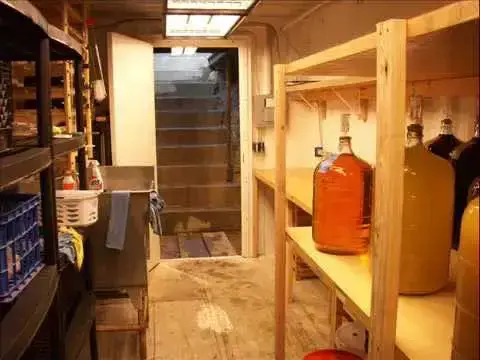
Construction, Foundation, and Maintenance
Proper construction, foundation, and maintenance are crucial for a functional and long lasting shipping container basement.
It is very wise to hire an experienced builder knowledgeable in container modifications and adaptations to ensure a sturdy and secure structure.
A proper foundation, such as concrete foundation or pilings, is absolutely important to spread the weight and properly support the container basement.
Regular inspections, waterproofing, and insulation are key to stay away from potential issues, such as leaks or condensation.
By putting in place proper construction techniques and maintenance practices, you can optimize the longevity and functionality of your shipping container basement.
Whether as an extra living space, a storage area, or a creative underground getaway, a container basement presents an innovative and efficient solution.
Unlock the potential of your property and create a unique and durable space with a shipping container basement.
Read More: How To Get Permits For Container Homes In Florida
Basement Construction
A. Types of Basements
When it comes to shipping container basements, there are different options to consider:
- Full basement: A full basement provides the most usable space and is ideal for those looking to maximize their storage capacity.
- Partial basement: A partial basement is a great option if you have specific needs and don’t require a full size basement.
- Crawl space: A crawl space basement offers limited head room but can be a cost effective solution for some.
Read More: 10 Surprising Benefits Of A Neat Container Green Roof
B. Construction Methods for Burying a Shipping Container and/or Basement
Building a shipping container basement requires careful planning and execution. Here are some construction methods to consider:
- Excavation: Proper digging up of the ground is crucial for creating a solid foundation for your container basement.
- Reinforcement: Reinforcing the walls and ceiling of the basement ensures structural integrity and supports the weight of the containers.
C. Considerations for Adding a Shipping Container as a Basement Structure
Before making up your mind to use shipping containers for your basement, it’s important to look at the feasibility and benefits:
- Feasibility: Consider factors such as site access, soil conditions, and drainage when determining if a shipping container basement is suitable for your property.
- Benefits: Shipping container basements offer advantages such as how long can it last, cost effectiveness, and faster construction compared to traditional basements.
Read More: Is Planning Permission Needed For Container Home? Expert Guide
Real Life Step-by-step 20 Foot Shipping Container Basement Project
Below are photos showing the project that we mentioned earlier that involved the use of a container as a basement.
This method can not only be used for a container basement. But also it can be used for someone who wants to burry a container and use it as a bunker, or any other related use.
Note that it is not limited to only 20 foot containers, but also 40 foot or any type, shape or size container.
Step 1: Selection of Suitable Location and Container for Shipping Container Basement Project
The first step, was looking for a good location. Preferably a location that has good drainage, gentle slope, great soil that was not too rocky, or made of clay.
Once this was done, a proper, Grade A, or B container size was picked. In this project, the builder used a 20 foot container.
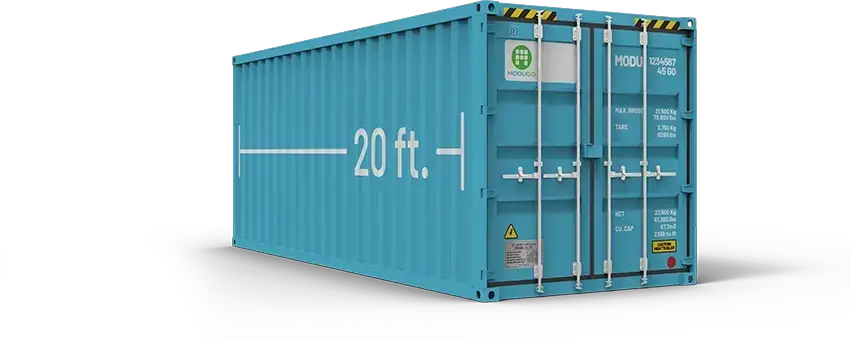
Step 2: Excavation and Container Foundation Laying
As you might have guessed it already, the second step was digging a hole big enough to accommodate the container. The hole was dug to be around 2 feet higher than the container itself.
After the excavation to the required height, a basic foundation that does not allow the container from sinking was put in place using peat and gravel to a level of six inches.
Follow this link on different types of shipping container home foundations by following the link. We touched on this extensively in that article.
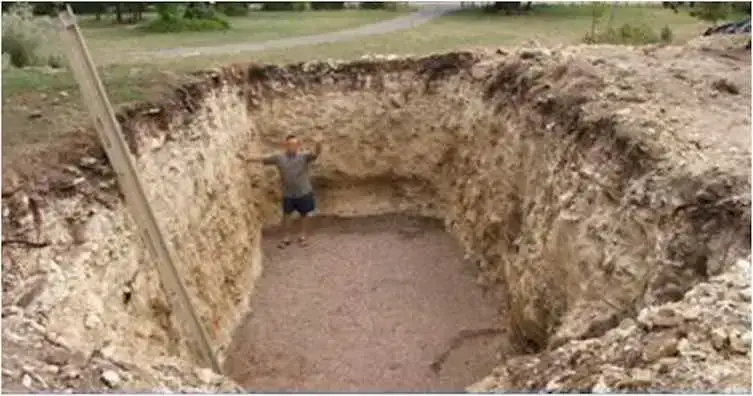
Step 3: Lowering Container Into Excavated Basement
This next step involved carefully lowering the container into the prepared excavated basement.

Step 4: Adding a Sump Pump and Steps
Once the container was in place, he used a bucket with holes for the sump pump. At the same time, he also constructed the steps to get to the basement.
And below is a photo of the steps after they were constructed.
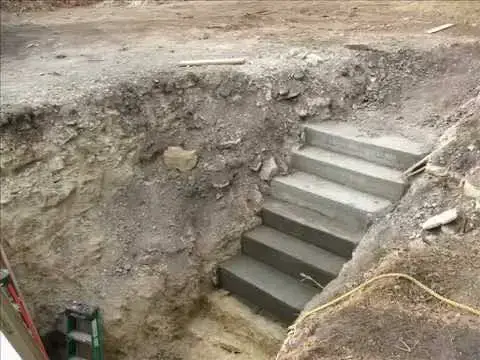
Step 5: Adding I-Beams at the Topmost Stair Case to the Container
The next step is adding I-beams from the floor level of the house or topmost part of the basement, welded to the 20 foot container. I-beams are a great choice due to their light weight and strength.
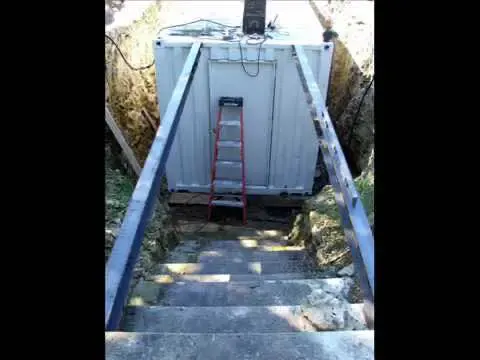
Step 6: Adding Framework to Support Superstructure
After adding the I-beams, extra framework is added to support the extra weight of the superstructure. Here’s how he did it.
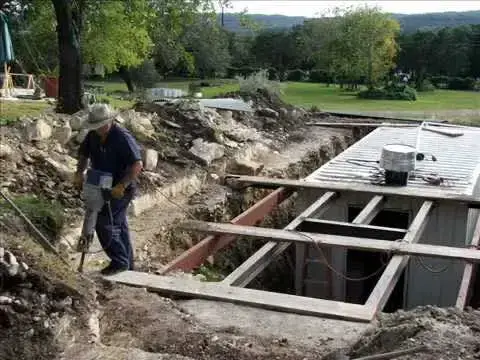
Step 7: Adding Corrugated Metal
Here, corrugated metal was used for added strength. This is in preparation for the floor slab which will be added later.
Corrugated metal strength come from a simple physics principle of Stress = F/A. The smaller the area, the higher the stress the material can withstand. Sorry for being a bit nerdy. But hey. 🙂
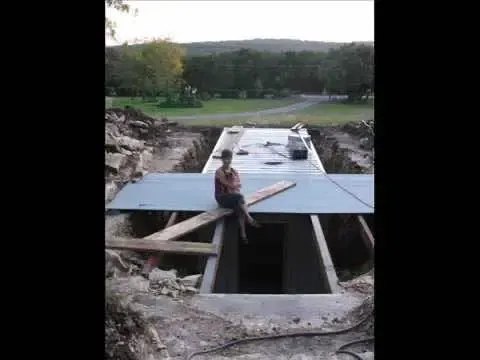
Step 8: Welding Rebars Around the Corrugated Steel Above the I-Beams
Remember the I-beams that were welded at the opening around the stairs earlier, and the corrugated steel that was added on top of it? Well, rebars are welded at equal spaces in preparation for blocks that will be added in the next step.
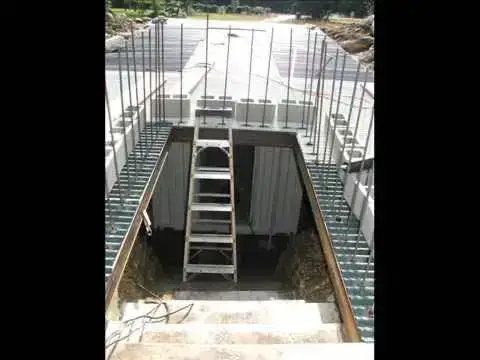
Step 9: Setting up Temporary Bracing
Since a layer of blocks is going to be added where the rebars were welded, temporary bracing is set up to take care of the extra weight.
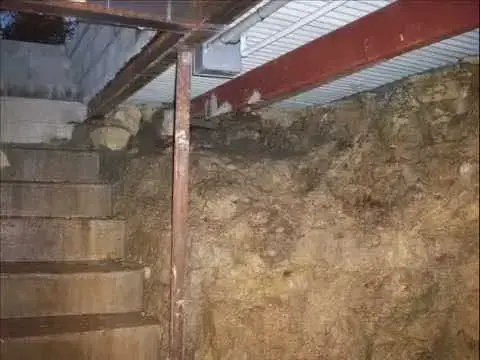
Step 10: Laying Blocks and Filling Them With Concrete Around the Entrance
Once the temporary bracing is in place, blocks are laid around the rebars that were placed earlier, and then they’re filled with concrete.
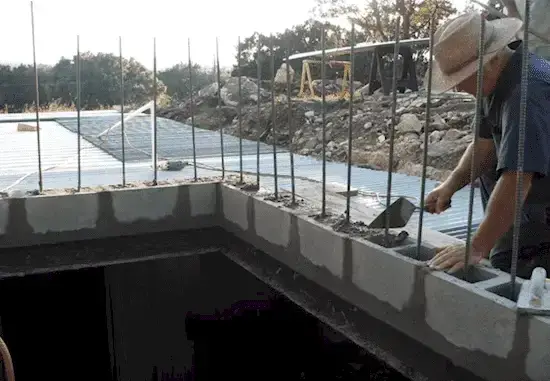
Step 11: Installing of 12-Inch Air Vents at Front and Back of the Container Basement
Next, holes were made on the roof of the container to allow for the addition of two 12-inch air vents. Air vents are necessary for any basement to allow for movement of air and prevent mold build up.
- 10" Diameter Wall-mounted Exhaust Fan from iLiving.
- Automatic shutter, variable speed controller, and thermostat.
- Powerful 65W motor with 820 CFM rating.
- 1200 sq.ft Coverage Area.
- Silver color.
- Low noise operation.
- Durable aluminum body with blades constructed from polypropylene plastic.
- Suitable for various ventilation and cooling applications.
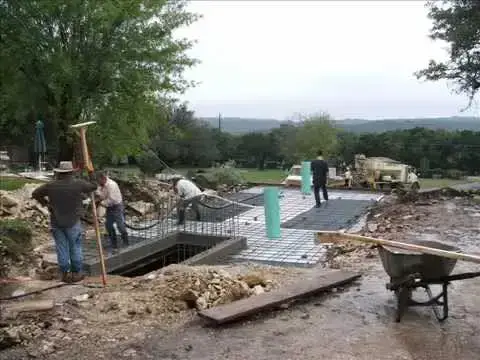
Step 12: Installing Electric Conduits for the Shipping Container Basement
The next step was putting the conduits for electricity and water supplies. These are usually added before cement is poured.
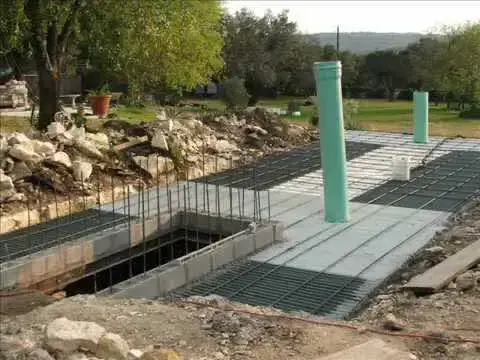
Step 13: Pouring of Concrete on the Buried Container
Finally, after making sure everything is in place, the next step is to start pouring the concrete. The amount of concrete pouted was six inches deep.
You can find out the volume of concrete you need and contact a local supplier of concrete. Alternatively, you can mix and pour the concrete on your own. A bit time consuming and tiring, but it’s an option.
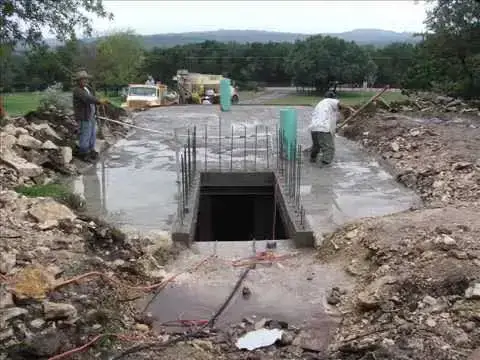
Step 13: Backfilling
After pouring of concrete, back filling is done to fill up the areas around the buried shipping container. This is performed once the concrete is set.
The formwork for the concrete is also removed. Formwork is the pieces of wood that are put in place to prevent the concrete from running or going to where it was not intended to.
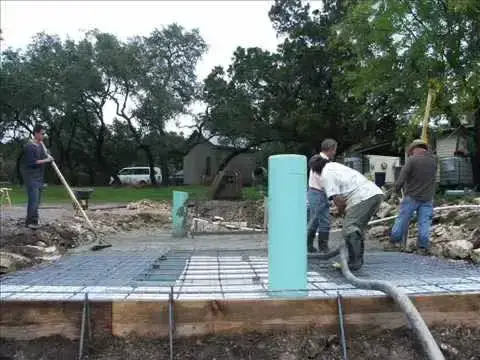
Step 14: Final Result of the Shipping Container Basement
The final result. Many Thomases out there would argue that you cannot burry a sea container or make a basement out of one. This real life example shows that it is possible.
Now, this is an old project done over 10 years ago at a price of roughly $12,000. Due to inflation and other factors, the price could be slightly higher in present day, but still cheap. You be the judge.


Video of the Construction Process of a Buried Shipping Container Basement
Below is a video of how the container basement was done.
Shipping Container Architecture
A. Applications of Shipping Containers in Architecture
Shipping containers have gained popularity in building design due to their versatility and cost effectiveness.
They can be used in various architectural projects, including homes, offices, and basements. The sturdy construction and modular nature of sea containers make them ideal for creating unique and innovative spaces.
Read More: How To Best Build A Shipping Container Home From Scratch
B. Advantages of Using Shipping Containers in Basement Construction
When it comes to basement construction, shipping containers offer several advantages. First, their structural integrity allows for easy integration into existing foundations.
Additionally, shipping containers are durable and resistant to weather conditions, ensuring a secure and long lasting basement.
Furthermore, the use of shipping containers can be more cost effective compared to traditional construction methods.
Read More: Can You Build A Shipping Container Home In Tennessee? Ultimate Guide
C. Creative Design Concepts for Shipping Container Basements
Container basements provide endless possibilities for creative design. They can be customized to fit specific needs and preferences, allowing homeowners to create the basement of their dreams.
With numerous examples, case studies, and inspirational ideas available, individuals can explore how to make their shipping container basement truly unique and functional.
Read More: Is It Cheaper To Build A Barndominium Or Container Home? Easy
Foundation Requirements for Shipping Container Basement
When it comes to constructing a shipping container basement, the foundation plays a crucial role. It does this by making sure that they are stable and can last a long time.
In this section, we will discuss the key factors to consider when finding more about the foundation requirements for your container basement.
Read More: 9 Creative Ideas For Shipping Container Home Design And Décor
A. Soil Type and Challenges
Before starting any construction project, it is important to analyze the soil conditions at the intended site. Different soil types present varying challenges and may require different foundation solutions.
- Clay soil: Clay soil can cause significant sliding and movement, leading to uneven settlements and issues to the structure. It is important to add proper drainage measures and choose foundation options that can take care of these challenges.
- Sandy soil: Sandy soil tends to be less stable and may require extra reinforcement. Consider adding foundation options that provide better stability for your shipping container basement.
- Rocky soil: Rocky soil can provide excellent stability, but the removal of soil process may be more difficult. Understanding the type of rocks in your soil can help determine the best foundation options.
By doing a proper soil analysis, you can be able to see potential challenges. It will also help you make sure that the proper foundation solution is used for your shipping container basement.
Read More: How To Build A Container Home For Beginners And Starters
B. Ensuring Stability and Durability
Stability and durability are the foundation needs that are vital to support a shipping container basement. To ensure these aspects, several strategies can be used:
- Concrete slab foundation: A solid concrete slab provides a stable base for you basement and helps spread the weight evenly.
- Pile foundation: Pile foundations, such as helical piles or driven piles, can be used to provide extra support and stability, especially in tricky soil conditions.
- Footings and piers: Footings and piers add to the spreading of the weight of a shipping container basement and can be customized based on the specific needs of the site.
By considering these foundation options, you can ensure that your shipping container basement remains stable and durable for years to come.
Read More: How Are Shipping Containers Identified? Expert Explanation
C. Compliance with Local Building Codes and Regulations
When building a shipping container basement, it is important to follow the local building codes and laws related to foundation needs. These codes are put in place to ensure the safety and structural integrity of the building.
Consult with a professional engineer or local building authorities to determine the specific foundation needs for your shipping container basement.
This step will help you avoid any potential legal issues and ensure that your construction meets the necessary standards.
Read More: Container Home Builders Tampa Florida: Here Are The Best
Waterproofing and Insulation of a Shipping Container Basement
To point out, a container basement can offer a unique and practical solution for expanding your living space.
However, to ensure that it lasts long and also for the comfort of your basement, it’s crucial to address two key factors: waterproofing and insulation.
A. Protecting Against Water Damage
To point out, water damage can wreak havoc on any basement, and a shipping container basement is no different. To protect against water related issues, there are several methods you can employ to properly waterproof your container basement.
Here are some of the best and popular methods that are used to work against water damage.
- Sealants: Applying good quality sealants to the outer and inner surfaces of your basement can create an impermeable barrier, preventing water infiltration.
- Drainage systems: Installing a drainage system that you can rely on, including French drains and sump pumps, can efficiently redirect any water away from your basement. This will reduce the risk of flooding.
- Vapor barriers: Utilizing vapor barriers can help control moisture levels by not letting water vapor from seeping into your basement.
Read More: Shipping Container Home In Adelaide – Expert Review
B. Strategies for Insulation of a Buried Shipping Container
To point out, to maintain comfortable temperatures and optimize energy efficiency in your container basement, proper insulation is necessary. Here are some guide on effective insulation techniques:
- Spray foam insulation: Spraying expanding foam insulation evenly across the walls and ceiling can create a seamless barrier, therefore lowers heat transfer and offering excellent insulation.
- Rigid foam insulation: Installing rigid foam panels on the interior walls and ceiling can provide insulation and act as a sound barrier, creating a comfortable and quiet living space.
- Batt insulation: Filling the stud cavities with fiberglass batt insulation can effectively insulate your container basement and minimize heat loss.
By carefully following these waterproofing and insulation strategies, you can ensure your shipping container basement remains dry, comfortable, and energy-efficient.
| Image | Product Title | Features | Price |
|---|---|---|---|
 | Buy on Amazon | ||
 | Buy on Amazon | ||
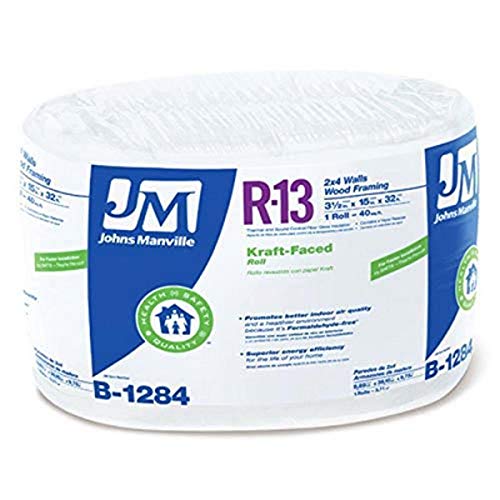 | Buy on Amazon |
Building Codes and Permits
When it comes to building a shipping container basement, there are certain building codes and permits that you need to be aware of.
This section will guide you through the necessary steps to obtain permits, adhere to local building codes, and understand safety laws.
A. Obtaining Permits
Before starting any construction project, including a shipping container basement, it’s important to understand the permit needs in your area. Each municipality may have different rules and laws to be followed, so it’s crucial to do your research.
To start, contact your local building department or permit office to inquire about the necessary permits. They will provide you with the specific application process, required documents, and any related fees.
Typically, you will need to submit complete plans and specifications of your shipping container basement. Note that this is including information about the foundation, structural elements, and electrical and plumbing systems.
The permit office will review these documents to ensure that they follow the local laws.
Read More: Which Air Compressor Is For Spray Painting? Here’s The Best
B. Adhering to Local Building Codes
Building codes are put in place to ensure the safety, structural integrity, and overall quality of construction projects. When building a shipping container basement, it’s crucial to adhere to these codes to ensure your project is up to standard.
Firstly, make sure that you understand the building codes specific to container basement construction in your area. These codes may cover areas such as foundation requirements, structural design, fire safety, and ventilation.
Keep in mind that building codes may be updated from time to time. And so it’s wise that you stay informed about any changes that may affect your project.
Failure to comply with local building codes can result in fines, delays, or even legal consequences.
Read More: How Do Shipping Containers Make Money?
C. Shipping Container Basement Safety Regulations
Building and maintaining a shipping container basement also involve sticking to the safety laws related to such type of construction. These laws are in place to protect both the builders and users of the structure.
During the construction phase, it’s important to make safety measures your priority. This includes making available the proper movement of air, using appropriate construction materials, and following electrical and plumbing safety steps and laws.
Once the shipping container basement is completed, regular maintenance and inspections are necessary to ensure ongoing safety. This includes inspections of foundation stability, waterproofing efficacy, and structural integrity.
On the whole, by understanding and sticking to safety laws, you can create a secure and reliable shipping container basement. A basement that complies with all necessary safety standards.
Read More: Affordable Homes Meaning – Simple Explanation
Advantages and Disadvantages of a Buried Shipping Container Basement
In this section, we will explore the advantages and disadvantages of using shipping containers as basements.
A. Pros of Using a Shipping Container as a Basement
- Cost-effectiveness: Shipping container basements offer a cost effective solution compared to traditional basement construction methods. The materials and labor required for creating a container basement are generally lower.
- Speed of construction: Container basements can be built relatively quickly compared to conventional basements. This is beneficial when time is a critical factor in the construction process.
- Sustainability: Using shipping containers as basements promotes sustainability as it makes use of recycled materials. It adds to reducing waste and conserving natural resources.
- Flexibility: Container basements provide flexibility in terms of design and customization. They can be easily changed to fit specific spatial needs and can be stacked or put next to each other to make unique architectural designs.
- Durability: Shipping containers are built to be able to take harsh weather conditions and transportation. As a basement structure, they offer excellent structural integrity and can take considerable loads.
- Portability: Container basements are portable, and allows to be moved from place to place if required. This aspect makes them suitable for temporary structures or situations where ease of movement is needed.
Read More: Affordable Homes In Defuniak Springs
B. Cons and Challenges
- Insulation: One of the main challenges with container basements is insulation. In truth, shipping containers are not naturally insulated, and extra insulation measures need to be done to control temperature and prevent water drops forming on the walls.
- Size limitations: The dimensions of shipping containers impose size limitations on the usable space for a basement. Effects such as headroom clearance and limited layout options should be considered.
- Remediation: Containers intended for shipping might have been exposed to chemicals or contaminants during transport. It is vital to perform remediation and ensure safety before using them as a habitable basement.
- Modifications and reinforcements: Now, according to the desired use and local building codes, container basements may require more changes and reinforcements to meet structural needs.
- Moisture control: Effective moisture control is crucial for container basements. Proper waterproofing measures need to be taken care of, and regular upkeep is necessary to prevent water infiltration and potential mold or mildew growth.
- Permits and regulations: Like any construction project, container basements must comply with local building codes and laws. It is necessary to obtain the necessary permits and ensure compliance during the construction process.
Read More: Can I Screw Into A Shipping Container? Simple Explanation
Structural Considerations
When utilizing shipping containers as a basement, it is crucial to consider the structural aspects to ensure a safe and stable foundation for your building. The following aspects should be taken into account:
A. Load-bearing Capacity
The load bearing capacity of shipping containers should be thoroughly examined when incorporating them into a basement design.
These containers are normally designed to stand and take the vertical loads during transportation, but their ability to bear extra horizontal and vertical loads in a basement setting may require further evaluation.
Must be remembered that talking to a structural engineer is highly advised to assess the individual load bearing capacity of each container and determine their suitability as load bearing elements within the basement structure.
B. Reinforcement Requirements
In order to ensure maximum stability and structural integrity, necessary changes and reinforcement techniques should be implemented.
Reinforcing the container walls by adding more support beams, columns, or bracing systems will enhance their ability to stand against outside pressures exerted by the soil and other structures that are around.
Additionally, reinforcing the connections between containers is vital to create a cohesive and robust basement structure.
These reinforcements should be designed and made according to engineering standards and guidelines.
Read More: Affordable Homes in Adelaide – Here’s How To Go About It
C. Potential Modifications for Stability
Examining design considerations for reinforcing container walls and their interaction with the ground structure is necessary for getting stability.
Techniques such as adding reinforcement plates, adding the wall thickness, or adding extra structural members can enhance the overall stability of the shipping container basement.
Additionally, considering factors such as soil type, water table levels, and seismic activity in the location can help inform the necessary changes for optimal stability.
Read More: How Do You Stabilize a Shipping Container? Easy Steps
Retrofitting Existing Basements
Are you looking to turn your current basement into a modern and innovative space? Consider modifying your basement using sea containers.
Above all, this cost effective solution can provide a range of benefits and give your basement a unique and contemporary feel.
Read More: How Do You Attach Wood To A Shipping Container? Easy Way
A. Converting an Existing Basement Into a Shipping Container Basement: Evaluating the Feasibility and Benefits of Retrofit Projects
Before starting on the journey on a retrofit project, it’s important to look at carefully the feasibility and benefits of converting your current basement using shipping containers.
At any rate, assess the structural integrity of your basement to ensure it can support the extra weight of the containers.
Consult with a professional engineer or architect to determine if any changes are needed to create a safe and secure space.
As shown above, one of the key benefits of modifying your basement is the wise use of space. Shipping containers can be stacked and connected together, maximizing every inch of your basement.
Transform your basement into a usable living area, a home office, or even a guest suite. To be sure, the possibilities are endless, and the modular nature of shipping containers allows for great flexibility in design.
Read More: Affordable Home Guarantee Scheme – What Is It?
B. Considerations for Retrofitting: Addressing the Necessary Modifications, Cost Implications, and Key Steps Involved in Converting an Existing Basement Using Shipping Containers
When making changes to your basement, there are several considerations to keep in mind. Firstly, you’ll need to address any necessary modifications, such as reinforcing the current foundation or making structural changes to be able to accept the containers.
Note that it is always important to consult with a professional builder who works closely with container conversions to ensure all necessary changes are made in the correct way.
Issues to do with cost are another important aspect to consider. Retrofitting your basement using shipping containers can be a cost effective solution compared to traditional renovation methods.
However, it’s important to budget for the necessary modifications, insulation, and final touches to create a comfortable and livable space.
What’s more, the key steps involved in changing the current basement using shipping containers include proper insulation, making sure that there is proper air movement, and taking care of any waterproofing needs.
Additionally, you’ll need to consider electrical and plumbing needs , as well as sticking to and with building codes and getting necessary permits.
To repeat, with careful planning and the right team of professionals, changing your current basement into a shipping container basement can be an exciting and transformative experience.
Finally, give your basement new life and enjoy the unique benefits of shipping container architecture.
Read More: Shipping Containers for Sale in North Carolina
Maintenance and Upkeep of a Buried Shipping Container Basement
A. Regular Maintenance Tasks That You Can Perform on Your Own
At length, here’s a careful and complete guide on routine maintenance activities to ensure the long lasting and functionality of a shipping container basement.
- Inspecting the exterior: Regularly inspect the container for any signs of damage, such as rust, leaks, or cracks. Address any issues quickly to prevent further damage.
- Checking for moisture: Regularly check for water drops or condensation inside the basement. Use a dehumidifier if necessary to maintain optimal humidity levels.
- Cleaning the interior: Regularly clean the inner surfaces of the container, including walls, floors, and fixtures, to remove dirt, dust, and potential mold or mildew.
- Inspecting the foundation: Periodically inspect the foundation of the basement for any signs of settlement or damage. Repair any cracks or issues to maintain structural integrity.
- Maintaining insulation: Check the insulation regularly to ensure it is intact and properly covering the walls and floors. Replace or repair any damaged insulation as needed. This is important since if not taken care of in time, energy loss and other problems such as rust and the like will set in.
Read More: Affordable Homes In Perth – Here’s What You Need To Know
B. Repair Considerations
Without a doubt, addressing potential repair needs and actionable tips for taking care of common issues in container basements:
- Addressing rust: If you notice any rust on the container, remove it using a wire brush and apply a rust resistant paint or coating to prevent further rusting. There are several product in the market that can stop and treat metal that has rust.
- Sealing leaks: If you detect any leaks, use a waterproof sealant to seal the affected areas and prevent water flowing in.
- Repairing cracks: If you discover any cracks in the container walls or floor, fill them with appropriate caulking or epoxy to prevent further damage. Do this in the shortest amount of time to prevent more damage.
- Fixing insulation issues: If the insulation becomes damaged or inadequate, replace it with new insulation material to maintain energy efficiency and temperature control.
Read More: Affordable Homes Of South Texas Weslaco – Expert Review
C. Overall Upkeep of Your Buried Basement
At this instant, we’ll be taking about best practices for keeping the quality of the container, interior space, and other elements of a shipping container basement:
- Regular cleaning: Keep the inner space clean and free from debris or clutter to maintain a healthy environment that works as expected.
- Manage humidity: Monitor and control humidity levels to prevent mold growth and keep the integrity of the container materials.
- Proper ventilation: Ensure enough opening to promote air movement and prevent moisture buildup.
- Inspect and maintain utilities: Regularly inspect and maintain any utilities or systems in the basement, such as electrical, plumbing, or HVAC, to ensure proper functionality.
Read More: Shipping Containers For Sale In Texas
Conclusion
Finally, after going through the various aspects of shipping container basements, it’s clear that they offer a unique and innovative solution for potential owners of homes in need of extra space.
In this article, we have covered important topics such as basement construction, foundation needs, waterproofing and insulation, building codes and permits, advantages and disadvantages, structural considerations, retrofitting the current basements, and maintenance and upkeep.
And so by looking at the summary of the key points covered in this article, we can add to the knowledge gained throughout the content plan.
Also, it’s crucial to remember that proper planning, construction, and maintenance are crucial for the success of a shipping container basement project.
Without carefully looking through and attention to detail, potential home owners may face road blocks and challenges.
Lastly, we urge readers to consult professionals familiar with shipping container architecture and construction to ensure that their projects meet building codes, safety standards, and personal liking.
To sum up, a professional builder or architect can provide valuable ideas and advice.
Read More: 4 Bedroom Shipping Container Home Cost – Expert Advice


